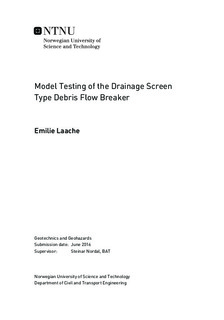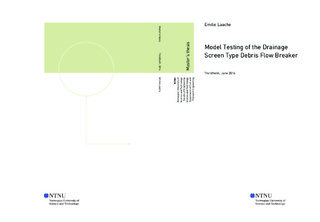| dc.description.abstract | Debris flows are a hazardous geological phenomenon occurring in mountainous terrain. In Norway the National Public Roads Administration has registered around 1060 debris flows since the 1970's. The damages caused by a debris flow can be severe and sometimes tragic. Countermeasures are therefore used to protect communities, infrastructure and agriculture from its large destructive powers.
Drainage screen type debris flow breakers are a countermeasure developed in Japan, but is not commonly used as local residents tend to be distrustful of its design. Japanese researchers named it debris flow breakers and it is designed as a drainage screen placed horizontally over the river bed where its purpose is to drain out the water from the debris flow that flows over. By removing the water the excess pore pressure along the shear surface is dissipated which then causes the debris flow to stop. In this thesis the drainage screen type debris flow breakers are referred to as debris flow breakers. This countermeasure is not mentioned in the NPRA's guidelines for debris flows and debris flow countermeasures, and there are only Japanese studies on the effectiveness and design of the debris flow breakers.
To investigate the effectiveness of these debris flow breakers, 27 tests were carried out in a physical debris flow model. First, three reference tests with no countermeasures were done. Then, 6 tests with two solid plates were conducted to investigate the effect of placing the breakers horizontally out of the channel instead of integrating them into the channel. Finally, 18 tests were done with 6 different drainage screen breakers with the lengths 0.5 and 1.0 m and 2, 4 and 6 mm opening widths. Their effectiveness was evaluated in terms of reduced runout compared to the reference tests.
The interaction between the debris flow and debris flow breaker appeared to be as the theory suggested. Water drained through and the debris flow front or body stopped on top of the breaker, depending on the length of the breaker. As a result of the stopped debris flow masses, the following part of the debris flow stopped as it flowed into the front. This damming effect caused the debris flow masses to accumulate upstream while the water drained through the masses and breakers. This upstream deposition height increased as the opening width of the debris flow breakers decreased. This was due to the amount of material that could pass through the different opening widths, the smaller opening the less material could pass and therefore accumulated upstream.
The results showed that the most effective debris flow breaker was 1.0 m long and had 2 mm opening widths. This breaker had a 76% effectiveness. All the 1.0 m long breakers had an effectiveness between 73-76% and were more effective than the 0.5 m long breakers whose effectiveness was between 23-41%, where the breaker with 2 mm opening widths was the most effective. The 1.0 m long breakers were also more effective than all the other countermeasures tested in the same model before. These countermeasures included a check dam, slit dams and baffles. In conclusion, the results from the physical modeling of the debris flow breakers indicate that they are an effective countermeasure that can be trusted and could be used. | |

